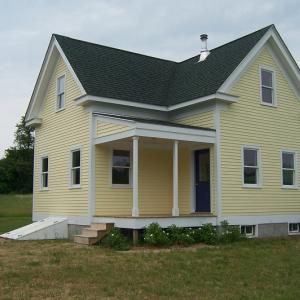Could you really live in 500-1,000 square foot house?
 1,000 square feet house: 3 bedroom, 2 bath, story and a half. Full basement. Photo courtesy Jim Bahoosh.
1,000 square feet house: 3 bedroom, 2 bath, story and a half. Full basement. Photo courtesy Jim Bahoosh.
 1,000 square feet house: 3 bedroom, 2 bath, story and a half. Full basement. Photo courtesy Jim Bahoosh.
1,000 square feet house: 3 bedroom, 2 bath, story and a half. Full basement. Photo courtesy Jim Bahoosh.
UNITY — There are some well known challenges to living in a small home, but solo builder Jim Bahoosh, who lives in a small home in Unity he built himself, finds that there are many more advantages, particularly in Maine.
After getting into the building industry in 1984 and renovating old houses, his interests gravitated toward building houses that are smaller than average new house. According to a 2017 report on national trends, the square footage of a single family newly built home is around 2,661.
“In the 1950s, a new house was about 800 square feet with more people in the house,” he said. “Over the years, things have dramatically shifted.”
By 2001, Bahoosh was designing and building houses between 500-1,000 feet. With $160.00 per square foot that translates to roughly $80,000 to $160,000, not including land, water, septic and site work.
“Some of the major costs of building are the same, no matter what size house you build,” he said. “Where a small house really shines is in the long term. They’re easy to heat and maintain.”
Bahoosh, who is committed to building projects for the next several years, said he is not interested in going much beyond that 500-1,000 square-foot range as a builder. He has to turn people away from retaining his services, now that the small house design has caught on so well in Maine. His upcoming talk at Hutchinson Center is not to generate business, but, instead, to generate more awareness of the advantages of a small house.
“For me, personally, it’s important to help people be aware that there is an option to build smaller and it’s not that big of a deal.”
On one hand, a smartly built small home with the proper insulation, is already ahead will be more energy efficient. Given that this winter is already seeing oil vendors facing challenges to keep up the supply for the demand, Bahoosh said: “A small home with comparable insulation to a big house is straight up physics, it’s going to take less fuel to bring the entire place up to temperature. Overall, small means reducing the amount of time to build it, to take care of it to heat it.”
Bahoosh, who has worked with many new homeowners, said that Maine is a state with a glut of old houses on the market with notoriously long and cold winters.
“It can be a double edged sword for someone trying to afford a house in their price range,” he said. “The mortgage might be manageable, but with this stock of older houses, the cost of maintaining the house, particularly those without good insulation, becomes unmanageable over time.”
Given that Bahoosh is at a place in his career where he can be discerning about what he chooses to build, he has a certain aesthetic, with an emphasis on natural building materials.
“If someone wants vinyl siding on their house, that’s fine but, I’m probably not going to be the person who is going to do that,” he said. “What you really need when you’re choosing a builder is to make sure your aesthetic sensibilities line up. Like every other relationship, you need to mesh.”
Some people just cannot imagine how they could live in such a small footprint. Bahoosh will discuss in his slideshow creative solutions to rearrange space to fit the homeowner’s main needs.
“A small house is more about what you truly need rather than what you want,” he said.
His talk at Hutchinson Center will feature several of the small homes he has built over the years, including his own. With a photo slide show, he wants to give the pros and cons of making the choice to live on a smaller footprint and will mention information on current Maine programs that increase energy efficiency on new or existing homes.
The free talk will be on Jan. 19 at The Hutchinson Center from 5:30 to 7p.m. Website: Hutchinson Center.
FMI: https://jimbahooshbuilder.com
Event Date
Address
United States



























